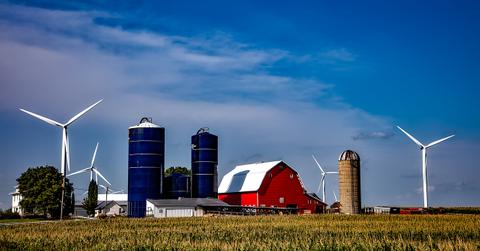How Rural Iowa Is Hooking Their Community On Solar Power
Farmers Electric, a utility company in rural Iowa, has set a gold standard in how to transition a community with old-school values to adopting the technology of solar generation. An eight-year process provided incentives and it's paid off.
Updated Aug. 9 2017, 2:54 p.m. ET
California isn't the only state switching over to solar energy in a big way. Even a small town in the state of Iowa that's typically ripe with old traditions has embraced the movement to solar power, thanks to the push by a local utility company.
Kalona, a town with a population of roughly 2,534 people, is 30 minutes southwest of Iowa City. Like many other small rural towns in the state, it’s rich with farmland and would be one of the last places you’d expect such growth in renewable energy. However, Farmers Electric Cooperative, a utility company serving nearly all of the town and surrounding area, was ahead of the transition over eight years ago.
Back then, Farmers Electric was already hoping to convince the community to switch over to solar generation. In order to do that, they knew the process would have to be cheap and they would have to show how it works. Warren McKenna, a manager at the co-op and leader of the solar division, explained that if it was easy to understand and either a neighbor or somebody else they knew adopted the technology, they would consider it.
Since solar panels weren’t as affordable back in 2008 as they are now, the focus wasn’t on lowering electric bills. Instead, it was to give out tax credits and issue a rebate program for those that adopted solar generation. Farmers Electric created a feed-in tariff program that pays consumers back based on the energy used. According to the Institute for Local Self-Reliance, these early investors are being paid $0.138 per kilowatt-hour, which is more than the retail rate of $0.125.
The feed-in tariff is a policy that’s worked in other countries, and it’s only helped that the cost of entry has decreased in recent years. Back in 2008, it cost roughly $5.50 per watt to buy in. Now, that cost is below $2.30 per watt and has removed the need of some rebate programs.
Consumers that either don’t live in an area of town that can efficiently generate solar power or aren’t willing to put them on their house can still dive into renewable energy. Farmers Electric has created two solar farms in town with a capacity of 1.8 megawatts, which feeds to over 120 households.
In order to meet peak demands that solar energy can’t keep up with, the utility company also spent $2 million to have local diesel generators. To stay consistent with their message of being local, they decided to own that energy generation instead of grabbing it from a bigger electric company.
Farmers Electric is well on pace to producing a quarter of its energy with renewable sources by 2025 -- they currently sit at 20 percent. It’s an incredible achievement for a local utility company to go through the work of making it an easy process to understand and the community of Kalona responded by slowly, but surely, adopting the new method.
